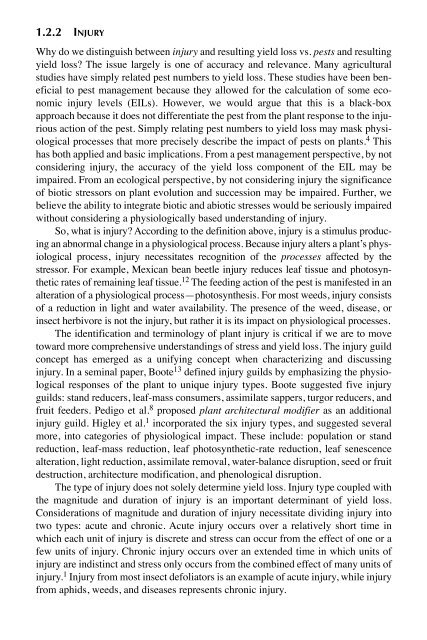Biotic Stress and Yield Loss
Biotic Stress and Yield Loss
Biotic Stress and Yield Loss
- No tags were found...
Create successful ePaper yourself
Turn your PDF publications into a flip-book with our unique Google optimized e-Paper software.
1.2.2 INJURYWhy do we distinguish between injury <strong>and</strong> resulting yield loss vs. pests <strong>and</strong> resultingyield loss? The issue largely is one of accuracy <strong>and</strong> relevance. Many agriculturalstudies have simply related pest numbers to yield loss. These studies have been beneficialto pest management because they allowed for the calculation of some economicinjury levels (EILs). However, we would argue that this is a black-boxapproach because it does not differentiate the pest from the plant response to the injuriousaction of the pest. Simply relating pest numbers to yield loss may mask physiologicalprocesses that more precisely describe the impact of pests on plants. 4 Thishas both applied <strong>and</strong> basic implications. From a pest management perspective, by notconsidering injury, the accuracy of the yield loss component of the EIL may beimpaired. From an ecological perspective, by not considering injury the significanceof biotic stressors on plant evolution <strong>and</strong> succession may be impaired. Further, webelieve the ability to integrate biotic <strong>and</strong> abiotic stresses would be seriously impairedwithout considering a physiologically based underst<strong>and</strong>ing of injury.So, what is injury? According to the definition above, injury is a stimulus producingan abnormal change in a physiological process. Because injury alters a plant’s physiologicalprocess, injury necessitates recognition of the processes affected by thestressor. For example, Mexican bean beetle injury reduces leaf tissue <strong>and</strong> photosyntheticrates of remaining leaf tissue. 12 The feeding action of the pest is manifested in analteration of a physiological process—photosynthesis. For most weeds, injury consistsof a reduction in light <strong>and</strong> water availability. The presence of the weed, disease, orinsect herbivore is not the injury, but rather it is its impact on physiological processes.The identification <strong>and</strong> terminology of plant injury is critical if we are to movetoward more comprehensive underst<strong>and</strong>ings of stress <strong>and</strong> yield loss. The injury guildconcept has emerged as a unifying concept when characterizing <strong>and</strong> discussinginjury. In a seminal paper, Boote 13 defined injury guilds by emphasizing the physiologicalresponses of the plant to unique injury types. Boote suggested five injuryguilds: st<strong>and</strong> reducers, leaf-mass consumers, assimilate sappers, turgor reducers, <strong>and</strong>fruit feeders. Pedigo et al. 8 proposed plant architectural modifier as an additionalinjury guild. Higley et al. 1 incorporated the six injury types, <strong>and</strong> suggested severalmore, into categories of physiological impact. These include: population or st<strong>and</strong>reduction, leaf-mass reduction, leaf photosynthetic-rate reduction, leaf senescencealteration, light reduction, assimilate removal, water-balance disruption, seed or fruitdestruction, architecture modification, <strong>and</strong> phenological disruption.The type of injury does not solely determine yield loss. Injury type coupled withthe magnitude <strong>and</strong> duration of injury is an important determinant of yield loss.Considerations of magnitude <strong>and</strong> duration of injury necessitate dividing injury intotwo types: acute <strong>and</strong> chronic. Acute injury occurs over a relatively short time inwhich each unit of injury is discrete <strong>and</strong> stress can occur from the effect of one or afew units of injury. Chronic injury occurs over an extended time in which units ofinjury are indistinct <strong>and</strong> stress only occurs from the combined effect of many units ofinjury. 1 Injury from most insect defoliators is an example of acute injury, while injuryfrom aphids, weeds, <strong>and</strong> diseases represents chronic injury.

















